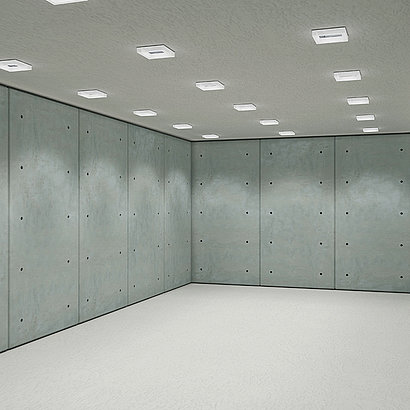FLOOD
Efficient illumination of large surfaces
When large surfaces are to be illuminated in an economical, user-oriented fashion, or with alternating furnishing, a uniform horizontal illumination is required. Whether it is a case of downlights with rotationally symmetric beams arranged in the form of a grid, or with linear luminaires. With a reduced direct glare, the angle of beam of 60° allows a sufficient component of vertical illumination on the wall. With the aid of predominantly diffusely radiating luminaires with a greater angle of beam, this component can be increased when the danger of direct glare increases.
SPOT
Effective dramatics of light
When the objective is to create atmospheres of light, then luminaires for halogen or high-pressure discharge lamps with narrow beams with small angles of radiation of 10 degrees are the right choice.Whether it is for the specific illumination of tables in bistros, reception areas or for presenting products, the vertical illumination which is only present due to its minimal reflection can be increased with the aid of swivelling luminaires.
ASYMMETRISCH
Zonal leadership
Illuminating surfaces only "from a basic approach" leads to something - literally. Zones of light such as these, serve as directional illumination without brightening-up the surroundings with large reflective components, i.e. in cinemas and conference rooms. Zones of light transition optically divide functional areas within a horizontal surface of others.
WALL AND ROOM-FLOODING
If walls - apart from fulfilling their function as architectural elements - are also to assume the function of reflective surfaces for indirect illumination, wallwash downlights can be deployed. This is because when arranged in the form of a grid in union with pure downlights, as well as their horizontal illumination they also integrate the wall itself in the lighting.
WALL MOUNTED
When walls are to be visually separated for aesthetic reasons, optical background lighting situations can be achieved via closely arranged wallwashers that open-up spaces. If artificial skylight situations are to be suggested, this can be achieved with continuous wall-mounted light bands. This can also be productive where surface structures of the wall are to be emphasised with the aid of steep incidences of light.
CEILING ACCENTS
Even with recessed ceiling light solutions, the ceiling does not necessarily have to mutate to a dark surface of room division. Light-optical accessories divide a proportion of the direct light and direct it towards the ceiling. The ceiling is partially brightened-up. In combination with light transmitting components that deliberately produce luminance on the optical accessory, the origin of the light source becomes a visible experience. This effect can be utilised for structural or guidance functions, but also for decorative purposes in order to demonstrate the importance of light.
PLACING IN THE CENTRE
When an object or a podium for presentation is to be brought into the limelight, an illumination from flatter angles is recommended in order to greatly increase the radiant intensity of the object in comparison to its surroundings. In the case of objects placed on a podium - for instance in a museum - floodlighting from a steep angle is more constructive. Firstly, in order to capture and accentuate the surface of the podium and secondly, in order the prevent the generation of disturbing shadows when the viewer enters the area of the beam angle.
DELIBERATE EMPHASIS
In order to illuminate smaller pictures and pillars, spotlights and floodlights with a homogenous quality of accentuation are the solution. If the surfaces to be illuminated are mirrored or highly polished, a lateral illumination should be chosen in order to avoid reflective glare. Steep angles of radiation accentuate textures better than flat angles, but often lead to annoying increases in shadow from the frame at the lower edges of the picture. In the case of large-format pictures, linear wallwash luminaires make more sense because they do not blot-out the information content of the pictures with disturbing cones of light.
SPATIAL EFFECTS
Depending upon the existing architecture, when illuminating round pillars or columns, it often makes more sense to place these in contrast to their surroundings rather than to accentuate them visually. This can be done with the aid of illuminating another surface of room division and the light reflected suffices in order to portray the plasticity of the pillar.

















